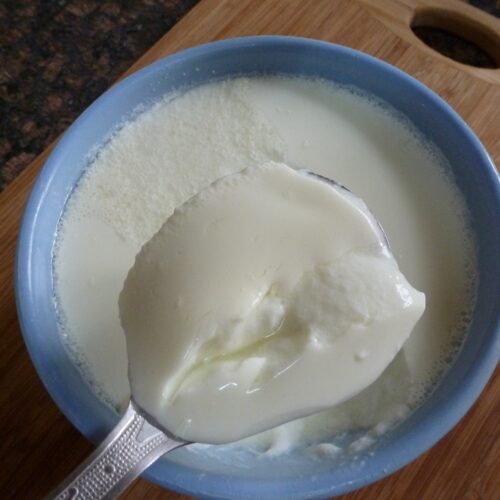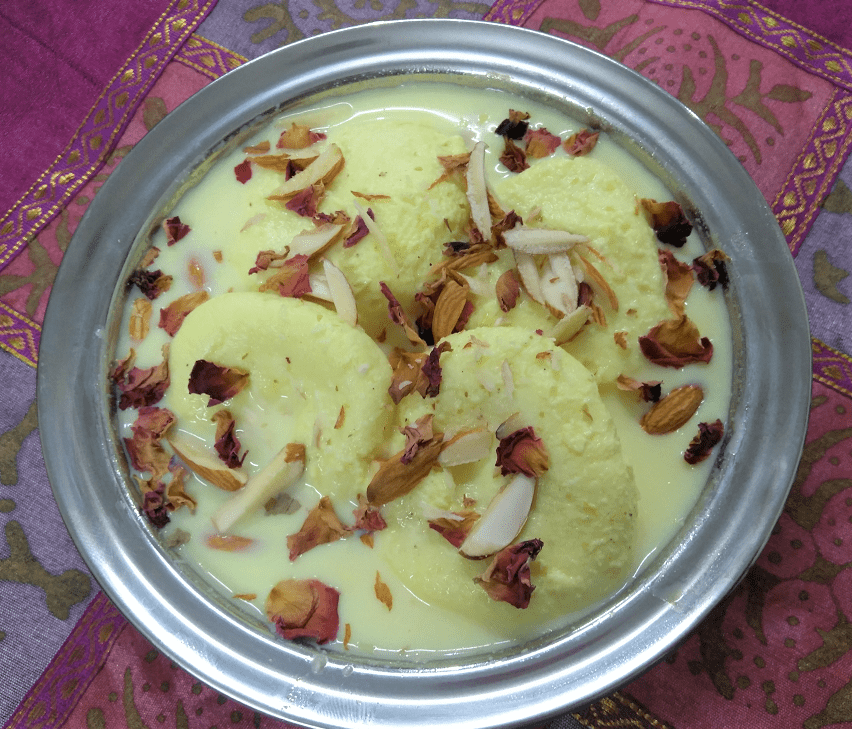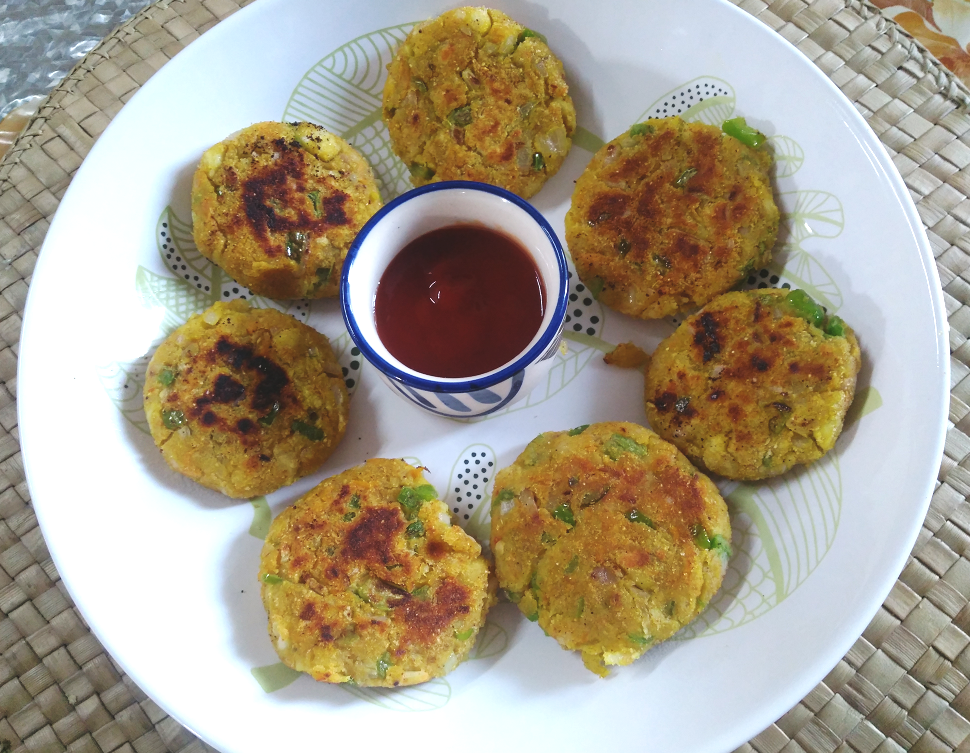How To Make Perfect Thick Curd With Toned Milk |Homemade Dahi- Step by step instructions and tips on how to set perfect thick curd with toned milk. Curd is an essential part of our daily meal in Indian households.

What is curd
Curd, which is also called dahi in Hindi and Yogurt in English is a rich probiotic food and good for our digestion and health. It is consumed daily in every Indian household. The making of curd at home is very simple and needs only two ingredients.
Curd is made by mixing a starter with warm milk and allowed to ferment for a few hours. Once the curd sets after the fermentation process, the consistency of the milk becomes like a thick pudding-like texture. Due to the bacterial fermentation, homemade curd has a tangy taste.
Curd is also known as dahi or Indian yogurt. But note that the yogurt available outside India is different than curd that we make in India at home.
Dahi is a fermented dairy product made with cow or buffalo milk. Dahi is used for making many Indian cuisine like papdi chaat, lassi, chaas, raita, dahi bhalla, etc. We also used it as a marinade base to make many starter dishes like tikka recipes and in the preparation rice dish like biryani, curd rice, etc. Some sweet dish are also made with using here yogurt as a main ingredient like shrikhand, cheesecake, Mishti doi, mousse, dahi ke shole, dahi ke kebab, etc.
Other curd recipes you would like to try
About the recipe
In this post, I will share some important tips and tricks that you we should keep in mind while you set curd at home. There is few things that is different in different weather conditions. So, here we are discussing how to make thick curd with toned milk during summers.
In summers, we face a lot of problem in setting curd. Sometimes, it become sour or or sometimes consistency is not perfect. All these issues we will be going to solve in this post.
Setting curd at home is a simple process that involves fermenting milk with the help of good bacteria to transform it into curd or yogurt. For making curd we can use fresh, pasteurized milk. You can use any type of milk, such as cow’s milk, buffalo milk, or plant-based milk alternatives like soy milk or almond milk.
This is a simple and easy method of preparing thick yogurt or Indian curd at home using toned milk and culture or starter.

Health benefits of consuming curd or dahi
Curd, also known as yogurt, is a dairy product that offers a range of health benefits. Here are some of the potential health benefits of consuming curd:
- Curd contains beneficial bacteria known as probiotics, such as Lactobacillus and Bifidobacterium strains. These probiotics help promote a healthy balance of gut bacteria, which is important for digestion, nutrient absorption, and overall gut health. They may also boost the immune system and help reduce the risk of certain gastrointestinal disorders.
- The probiotics in curd can aid in digestion by breaking down lactose, the sugar found in milk. This makes curd easier to digest for individuals with lactose intolerance. Additionally, curd can help alleviate common digestive issues like bloating, constipation, and diarrhea.
- The probiotics in curd can improve the absorption of various nutrients, such as calcium, iron, and B vitamins. This is particularly beneficial for individuals with low stomach acid or those who struggle with nutrient deficiencies.
- Curd is a good source of calcium, which is essential for strong and healthy bones. Regular consumption of curd can contribute to maintaining bone density and reducing the risk of osteoporosis, especially in combination with a calcium-rich diet.
- Curd is a rich source of protein, which is important for the growth and repair of tissues, muscle development, and the production of enzymes and hormones. Including curd in your diet can help meet your daily protein requirements, especially for vegetarians or those who have limited meat intake.
- Curd is relatively low in calories and can be a healthy addition to a weight management plan. The protein and calcium in curd can promote feelings of fullness and help control appetite, making it a satisfying and nutritious snack option.
- The probiotics in curd may support a healthy immune system by promoting a balanced gut microbiome. A strong and diverse gut microbiota can help protect against infections, boost immune responses, and reduce the risk of certain immune-related conditions.
It’s important to note that individual experiences may vary, and the specific health benefits of curd can depend on factors such as the quality of the curd, the presence and quantity of probiotics, and personal health conditions. If you have any specific health concerns, it’s always a good idea to consult with a healthcare professional or a registered dietitian for personalized advice.
Step by step preparation of curd /dahi with toned milk at home
1.Transfer a litre or 910 ml milk in a sauce pan. Put the pan on medium heat and bring to boil the milk.
2. Once the milk start boiling, keep it on simmer for 1-2 minutes and then switch off the flame.


3. Let it cool down to the lukewarm stage.
4. Check it with finger if you can keep your finger comfortably in the milk for 10-15 seconds, this is the right temperature to set the curd.


5. Now remove cream(malai) layer from the milk. Take 2 cups or 500 ml milk in a separate vessel.
6. Take another bowl, add 1 tsp starter(previous day curd) and whisk it well.


7. Now add lukewarm milk to it and mix very well.
8. Cover the bowl and put it aside without disturbing till the curd sets. It will takes around somewhere 3-4 hours in the summer depends on the weather conditions.


9. Check the curd after 4 hours if it set put it in the refrigerator for 2-3 hours before serving.
10. If curd is still loose wait for another 30-45 minutes and check again. Follow the same steps after that.
11. Enjoy! curd with roti and sabji or dal chawal. You can make lassi or shake with it.
Serving suggestions
Serve chilled curd or dahi with meal or can make lassi or shake with it.
Tips and tricks
- Start with fresh, pasteurized milk to ensure the best results. Avoid using milk close to its expiration date or milk that has been sitting in the fridge for too long.
- Select a good quality starter culture to set your curd. This can be a small amount of curd from a previous batch or store-bought yogurt with live and active cultures. Make sure the starter culture doesn’t contain any additives or sweeteners.
- Ensure that all utensils, pots, and containers used in the curd-making process are clean and sterilized. Any residual bacteria or contaminants can affect the quality and taste of the curd.
- Temperature control is crucial for curd formation. Heat the milk to the right temperature range (around 185°F or 85°C) for proper sterilization, then cool it down to a lukewarm temperature (around 105-110°F or 40-43°C) before adding the starter culture. Use a kitchen thermometer to accurately monitor the temperature.
- It’s important to provide a consistently warm environment for the curd to ferment. You can place the pot near a warm oven, on a heating pad set to low, or use a yogurt maker with temperature control. Wrapping the pot in a clean cloth or placing it in a closed microwave (not turned on) can also help maintain the warmth.
- Allow sufficient time for the curd to set and ferment. The fermentation process typically takes around 6 to 8 hours, but it may vary depending on factors like temperature and desired tartness. Avoid disturbing or moving the pot during this time, as it can disrupt the curd-setting process.
- If the curd doesn’t set within the recommended time, you can extend the fermentation period by a couple of hours until the desired consistency is achieved. Conversely, if the curd sets too quickly and becomes too sour, you can reduce the fermentation time in the future.
- After the curd has set, refrigerate it for a few hours to enhance its texture and taste. This will also help slow down further fermentation and preserve the curd’s freshness.
By following these tips and tricks, you can increase the chances of successfully making delicious homemade curd with the desired consistency and flavor. Don’t hesitate to experiment and adjust the process according to your preferences until you achieve the perfect batch of curd.
Recipe card

How To Make Perfect Thick Curd With Toned Milk|Homemade Dahi
Ingredients
- 500 ml toned milk boiled and cooled
- 1 tsp thick starter
Instructions
- Transfer a litre or 910 ml milk in a sauce pan. Put the pan on medium heat and bring to boil the milk.
- Once the milk start boiling, keep it on simmer for 1-2 minutes and then switch off the flame.
- Let it cool down to the lukewarm stage.
- Check it with finger if you can keep your finger comfortably in the milk for 10-15 seconds, this is the right temperature to set the curd.
- Now remove cream(malai) layer from the milk. Take 2 cups or 500 ml milk in a separate vessel.
- Take another bowl, add 1 tsp starter(previous day curd) and whisk it well.
- Now add lukewarm milk to it and mix very well.
- Cover the bowl and put it aside without disturbing till the curd sets. It will takes around somewhere 3-4 hours in the summer depends on the weather conditions.
- Check the curd after 4 hours if it set put it in the refrigerator for 2-3 hours before serving.
- If curd is still loose wait for another 30-45 minutes and check again. Follow the same steps after that.
- Enjoy! curd with roti and sabji or dal chawal. You can make lassi or shake with it.
- Tips and tricks
Notes
- Start with fresh, pasteurized milk to ensure the best results. Avoid using milk close to its expiration date or milk that has been sitting in the fridge for too long.
- Select a good quality starter culture to set your curd. This can be a small amount of curd from a previous batch or store-bought yogurt with live and active cultures. Make sure the starter culture doesn’t contain any additives or sweeteners.
- Ensure that all utensils, pots, and containers used in the curd-making process are clean and sterilized. Any residual bacteria or contaminants can affect the quality and taste of the curd.
- Temperature control is crucial for curd formation. Heat the milk to the right temperature range (around 185°F or 85°C) for proper sterilization, then cool it down to a lukewarm temperature (around 105-110°F or 40-43°C) before adding the starter culture. Use a kitchen thermometer to accurately monitor the temperature.
- It’s important to provide a consistently warm environment for the curd to ferment. You can place the pot near a warm oven, on a heating pad set to low, or use a yogurt maker with temperature control. Wrapping the pot in a clean cloth or placing it in a closed microwave (not turned on) can also help maintain the warmth.
- Allow sufficient time for the curd to set and ferment. The fermentation process typically takes around 6 to 8 hours, but it may vary depending on factors like temperature and desired tartness. Avoid disturbing or moving the pot during this time, as it can disrupt the curd-setting process.
- If the curd doesn’t set within the recommended time, you can extend the fermentation period by a couple of hours until the desired consistency is achieved. Conversely, if the curd sets too quickly and becomes too sour, you can reduce the fermentation time in the future.
- After the curd has set, refrigerate it for a few hours to enhance its texture and taste. This will also help slow down further fermentation and preserve the curd’s freshness. By following these tips and tricks, you can increase the chances of successfully making delicious homemade curd with the desired consistency and flavor. Don’t hesitate to experiment and adjust the process according to your preferences until you achieve the perfect batch of curd.
My latest video
Try to set your curd at home with these tips and tricks. If you like the recipe share it with your friends and family and don’t forget to give us a 5 star rating. How it works for you, take a picture and tag it #healthicallykitchen on Instagram. Or, save it for later on Pinterest. I love to see them. Happy cooking!






